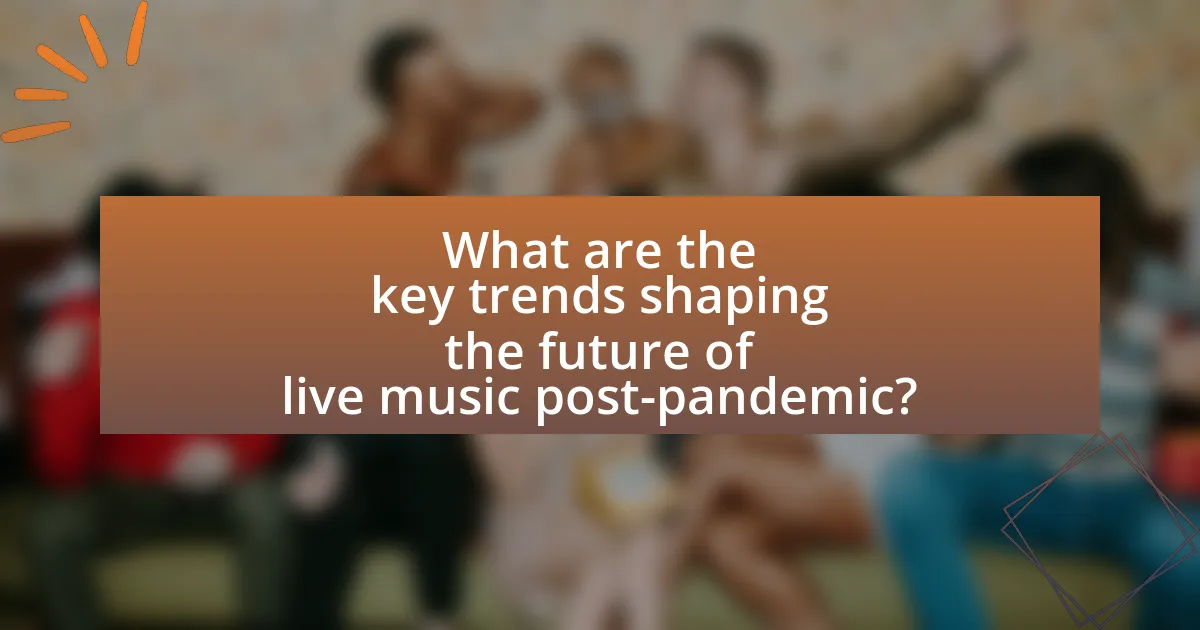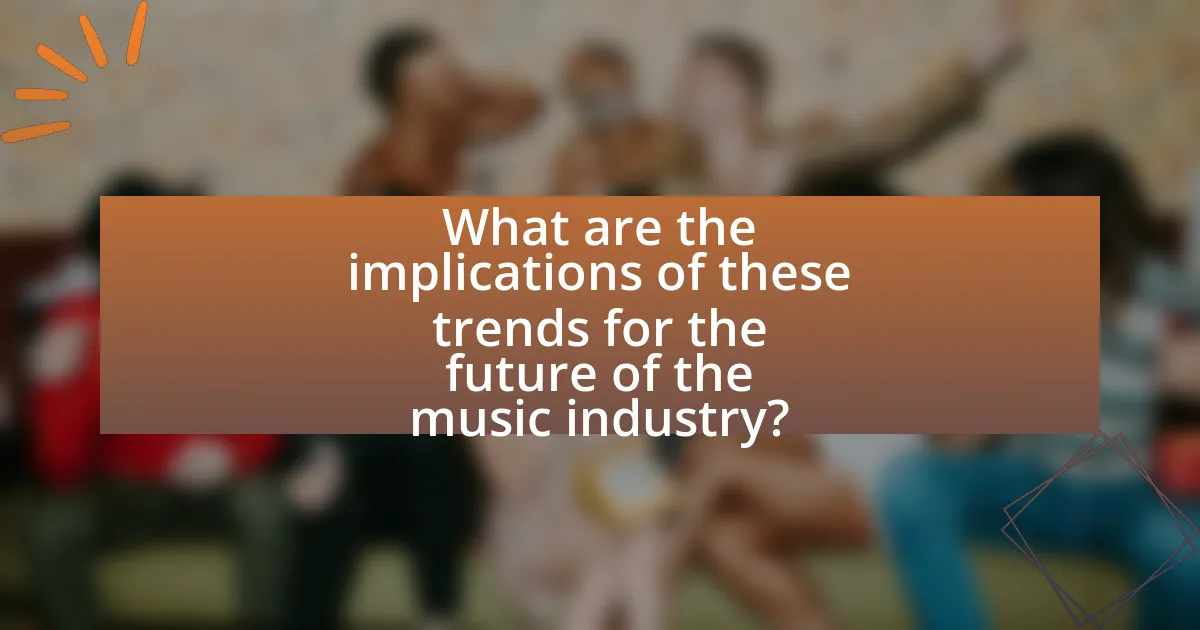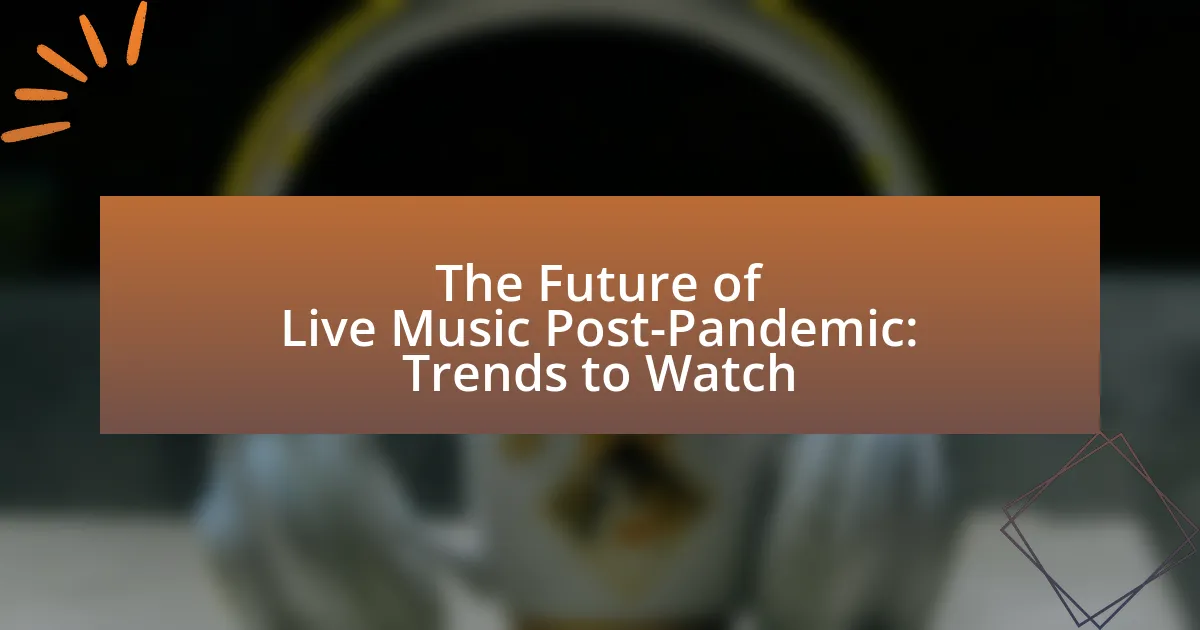The article focuses on the future of live music in the post-pandemic landscape, highlighting key trends such as the increased reliance on technology, the rise of hybrid events, and a heightened emphasis on health and safety. It examines how audience behavior has shifted, with a preference for outdoor venues and flexible ticketing options, as well as the impact of safety concerns on attendance. Additionally, the article discusses technological advancements like virtual reality and live streaming that are reshaping live music experiences, and outlines strategies for artists and venues to adapt to these changes, ensuring successful engagement with audiences in a transformed environment.

What are the key trends shaping the future of live music post-pandemic?
The key trends shaping the future of live music post-pandemic include increased reliance on technology, hybrid events, and a focus on health and safety. Technology has become essential, with artists and venues utilizing livestreaming and virtual reality to reach wider audiences; for instance, platforms like Twitch and YouTube have gained popularity for live performances. Hybrid events, which combine in-person and virtual attendance, are becoming standard, allowing fans to choose their preferred experience. Additionally, health and safety measures, such as contactless entry and enhanced sanitation protocols, are now prioritized to ensure audience confidence, as evidenced by the implementation of these practices in major festivals like Coachella and Lollapalooza.
How has the pandemic changed audience behavior in live music?
The pandemic has significantly altered audience behavior in live music by increasing the demand for virtual experiences and enhancing health and safety awareness. Audiences have become more selective about attending live events, prioritizing safety measures such as social distancing and mask-wearing, which has led to a rise in hybrid events that combine in-person and online participation. According to a survey by Eventbrite, 70% of respondents expressed a preference for outdoor events, reflecting a shift towards safer environments. Additionally, the convenience of streaming has made audiences more accustomed to accessing performances from home, which has prompted artists and venues to adapt their offerings to include digital content.
What new preferences have emerged among concert-goers?
New preferences among concert-goers include a heightened demand for outdoor venues, flexible ticketing options, and enhanced health and safety measures. Concert-goers increasingly favor outdoor settings due to perceived safety from COVID-19, with a survey indicating that 70% of attendees prefer open-air concerts. Additionally, flexible ticketing, such as options for refunds or exchanges, has become essential, as 65% of fans express a desire for more adaptable purchasing policies. Health protocols, including contactless entry and sanitation stations, are now expected, with 80% of attendees prioritizing venues that implement these measures.
How are safety concerns influencing attendance at live events?
Safety concerns are significantly influencing attendance at live events by causing many potential attendees to hesitate or opt out altogether. Research indicates that 60% of individuals express anxiety about attending crowded venues due to fears of health risks, particularly in the context of lingering pandemic effects. This apprehension is compounded by reports of increased security measures and health protocols, which, while intended to enhance safety, can also deter attendance by creating an atmosphere of unease. Consequently, event organizers are adapting by implementing stricter health guidelines and offering virtual attendance options, reflecting a shift in consumer behavior driven by safety considerations.
What technological advancements are impacting live music experiences?
Technological advancements significantly impacting live music experiences include virtual reality (VR), augmented reality (AR), and live streaming technologies. VR and AR enhance audience engagement by creating immersive environments, allowing fans to experience concerts from unique perspectives, such as front-row seats from their homes. For instance, platforms like Oculus Venues enable users to attend live events in a virtual space, providing a sense of presence that traditional streaming lacks. Live streaming technologies have also evolved, with high-definition video and multi-camera setups enabling artists to reach global audiences, as seen during events like the 2020 Global Citizen concert, which attracted millions of viewers online. These advancements not only enhance the experience for attendees but also expand the reach and accessibility of live music events.
How is virtual reality being integrated into live performances?
Virtual reality is being integrated into live performances by creating immersive experiences that enhance audience engagement and interaction. For instance, artists are utilizing VR technology to allow fans to experience concerts from unique perspectives, such as front-row seats or even on stage with performers. This integration has been exemplified by events like the Travis Scott concert in Fortnite, which attracted millions of viewers and showcased how virtual environments can host live music events. Additionally, companies like Oculus and VRChat are developing platforms that enable virtual concerts, allowing artists to reach global audiences without geographical limitations. These advancements indicate a significant shift in how live performances are experienced, making them more accessible and interactive for fans.
What role does streaming technology play in the future of live music?
Streaming technology is pivotal in shaping the future of live music by expanding audience reach and enhancing artist engagement. It allows artists to perform live concerts to global audiences, breaking geographical barriers that previously limited attendance. For instance, during the COVID-19 pandemic, platforms like Twitch and YouTube Live facilitated over 1,000 virtual concerts, demonstrating a significant shift in how audiences consume live music. Additionally, streaming technology enables interactive features such as real-time audience feedback and virtual meet-and-greets, fostering a deeper connection between artists and fans. This evolution not only diversifies revenue streams for artists but also transforms the live music experience into a more inclusive and accessible format.

How are artists and venues adapting to the post-pandemic landscape?
Artists and venues are adapting to the post-pandemic landscape by implementing hybrid models that combine live performances with virtual streaming options. This approach allows artists to reach wider audiences while accommodating those who may still be hesitant to attend in-person events. For instance, many venues have upgraded their technology to facilitate high-quality live streaming, enabling them to sell tickets for both physical attendance and online viewing. Additionally, artists are increasingly engaging with fans through social media and digital platforms to maintain connections and promote their work. According to a survey by the National Independent Venue Association, 90% of independent venues reported that they are now offering virtual events as part of their programming, highlighting a significant shift in how live music is presented.
What strategies are artists using to engage with fans?
Artists are using social media platforms, live streaming events, and personalized content to engage with fans. Social media allows artists to communicate directly with their audience, share behind-the-scenes content, and create interactive experiences through polls and Q&A sessions. Live streaming events have become increasingly popular, enabling artists to perform for fans in real-time, regardless of geographical barriers, which was particularly significant during the pandemic when in-person events were limited. Additionally, personalized content, such as tailored messages or exclusive merchandise, fosters a deeper connection between artists and their fans, enhancing loyalty and engagement. These strategies reflect a shift towards more direct and meaningful interactions in the post-pandemic music landscape.
How are social media platforms being utilized for live performances?
Social media platforms are being utilized for live performances by enabling artists to stream concerts and engage with audiences in real-time. Platforms like Instagram, Facebook, and YouTube allow musicians to reach global audiences, facilitating virtual events that can attract thousands of viewers simultaneously. For instance, a report from the International Music Summit in 2021 indicated that 60% of artists used social media for live streaming during the pandemic, highlighting its role in maintaining fan connections and generating revenue through virtual ticket sales and donations. This shift not only expanded the reach of live performances but also transformed audience interaction, allowing for immediate feedback and engagement through comments and reactions.
What innovative marketing techniques are emerging in the live music scene?
Innovative marketing techniques emerging in the live music scene include the use of augmented reality (AR) experiences and personalized fan engagement through data analytics. AR enhances live performances by allowing fans to interact with digital elements during shows, creating a more immersive experience. For instance, artists like Travis Scott have successfully integrated AR into their concerts, resulting in increased audience engagement and ticket sales. Additionally, data analytics enables promoters to tailor marketing strategies based on fan preferences and behaviors, leading to more effective targeting and higher conversion rates. According to a report by Eventbrite, 70% of event organizers are leveraging data to enhance their marketing efforts, demonstrating the growing importance of these techniques in the live music industry.
How are venues rethinking their operations and layouts?
Venues are rethinking their operations and layouts by implementing flexible seating arrangements and enhancing health protocols. This shift aims to accommodate social distancing and improve audience safety, which has become a priority post-pandemic. For instance, many venues are adopting modular seating that can be easily rearranged to create more space between attendees, allowing for a safer environment. Additionally, venues are integrating technology for contactless entry and payment systems, which streamline operations and reduce physical interactions. These changes reflect a broader trend in the live music industry to adapt to new health standards and consumer expectations, ensuring a safer and more enjoyable experience for audiences.
What changes are being made to enhance audience safety and comfort?
Changes being made to enhance audience safety and comfort include implementing advanced health protocols, improving venue ventilation, and utilizing contactless technology. Venues are adopting measures such as mandatory health screenings, increased sanitation practices, and social distancing arrangements to ensure a safer environment. For instance, many venues have upgraded their air filtration systems to meet higher standards, which significantly reduces airborne pathogens. Additionally, the use of mobile apps for ticketing and ordering concessions minimizes physical contact, further enhancing the audience’s comfort and safety during events.
How are venues incorporating hybrid models for events?
Venues are incorporating hybrid models for events by integrating both in-person and virtual attendance options. This approach allows venues to reach a broader audience, as evidenced by a 2021 survey from Eventbrite, which found that 67% of event organizers planned to offer hybrid experiences to accommodate diverse attendee preferences. Venues are utilizing advanced technology, such as live streaming equipment and interactive platforms, to enhance engagement for remote participants, ensuring that both in-person and virtual attendees can interact seamlessly.

What are the implications of these trends for the future of the music industry?
The implications of current trends for the future of the music industry include a significant shift towards digital platforms and hybrid event models. As live music events adapt to post-pandemic realities, artists and promoters are increasingly leveraging technology to reach wider audiences through virtual concerts and streaming services. According to a report by the International Music Summit, the global music streaming market is projected to grow to $23.1 billion by 2025, indicating a strong consumer preference for digital consumption. Additionally, the rise of social media as a promotional tool has transformed how artists engage with fans, leading to more personalized experiences and direct-to-consumer sales. These trends suggest that the music industry will continue to evolve, prioritizing flexibility and innovation in how music is produced, distributed, and consumed.
How will the economic landscape of live music evolve?
The economic landscape of live music will evolve towards increased digital integration and diversified revenue streams. As live events recover from pandemic disruptions, artists and venues are likely to adopt hybrid models that combine in-person experiences with virtual access, enhancing audience reach and engagement. For instance, a report from the International Live Music Conference indicates that 70% of promoters plan to incorporate live streaming into their events to attract global audiences. Additionally, the rise of subscription-based platforms and direct-to-fan sales will provide artists with alternative income sources, reducing reliance on traditional ticket sales. This shift reflects a broader trend towards adaptability and innovation in the live music sector, driven by changing consumer preferences and technological advancements.
What financial challenges do artists and venues face moving forward?
Artists and venues face significant financial challenges moving forward, primarily due to reduced audience capacity and increased operational costs. The COVID-19 pandemic has led to lasting changes in consumer behavior, with many attendees remaining hesitant to return to crowded spaces, which directly impacts ticket sales. Additionally, venues are now required to implement enhanced health and safety measures, increasing their operational expenses. According to a report by the National Independent Venue Association, 90% of independent venues reported being at risk of permanent closure without additional financial support. This combination of decreased revenue and rising costs creates a precarious financial landscape for both artists and venues as they navigate the post-pandemic recovery.
How might ticket pricing structures change in response to new trends?
Ticket pricing structures may change by adopting dynamic pricing models that reflect real-time demand and consumer behavior. This shift is influenced by trends such as increased digital engagement and the rise of personalized experiences in live events. For instance, data from the live event industry indicates that dynamic pricing can optimize revenue by adjusting ticket prices based on factors like sales velocity and remaining inventory, similar to practices seen in airline and hotel industries. Additionally, the integration of technology, such as mobile apps and data analytics, allows promoters to tailor pricing strategies to specific audience segments, enhancing both accessibility and profitability.
What best practices can artists and venues adopt for success in the new environment?
Artists and venues can adopt several best practices for success in the new environment, including embracing digital platforms, enhancing audience engagement, and prioritizing health and safety measures. Utilizing digital platforms allows artists to reach wider audiences through live streaming and virtual events, which became essential during the pandemic and continue to be relevant. For instance, a report by Eventbrite indicates that 67% of event creators plan to incorporate hybrid events, combining in-person and virtual experiences, to maximize reach and engagement.
Enhancing audience engagement through personalized experiences, such as interactive social media campaigns and exclusive content, fosters a stronger connection with fans. According to a study by Nielsen, 70% of consumers are more likely to engage with brands that offer personalized experiences.
Prioritizing health and safety measures, such as implementing contactless ticketing and ensuring proper sanitation protocols, builds trust with attendees. The National Independent Venue Association reported that venues that adopted strict health guidelines saw a 30% increase in ticket sales post-reopening. By integrating these practices, artists and venues can navigate the evolving landscape of live music effectively.
How can artists effectively leverage technology to enhance their performances?
Artists can effectively leverage technology to enhance their performances by utilizing advanced audio-visual tools, interactive platforms, and social media engagement. For instance, the integration of augmented reality (AR) and virtual reality (VR) can create immersive experiences that captivate audiences, as seen in the 2020 Travis Scott concert in Fortnite, which attracted over 12 million viewers. Additionally, live streaming technology allows artists to reach global audiences, expanding their fan base beyond physical venues. According to a report by Eventbrite, 67% of event organizers plan to incorporate hybrid events, combining in-person and virtual elements, to enhance audience engagement. By adopting these technologies, artists can create unique, memorable performances that resonate with diverse audiences.
What are the key considerations for venues when planning future events?
Key considerations for venues when planning future events include health and safety protocols, audience capacity, and technology integration. Venues must prioritize health measures, such as sanitation and social distancing, to ensure attendee safety, especially in a post-pandemic context where public health remains a concern. Audience capacity is crucial as venues need to comply with local regulations and adapt to changing guidelines, which can affect ticket sales and revenue. Additionally, technology integration, including virtual streaming options and enhanced sound and lighting systems, is essential to meet evolving audience expectations and expand reach. These considerations are supported by industry reports indicating that venues that adapt to these factors are more likely to succeed in the current landscape.
What practical tips can artists and venues implement to thrive post-pandemic?
Artists and venues can thrive post-pandemic by adopting flexible programming and enhancing digital engagement. Flexible programming allows for adjustments based on audience preferences and health guidelines, which is crucial as live events may still face restrictions. For instance, venues can offer a mix of in-person and virtual performances to cater to diverse audience comfort levels. Enhancing digital engagement through social media and streaming platforms can expand reach and maintain audience connection, as evidenced by a 2021 report from the International Live Music Conference, which highlighted that 70% of audiences appreciated hybrid events. Additionally, implementing health and safety protocols, such as contactless ticketing and improved ventilation, can build audience confidence in attending live events.
